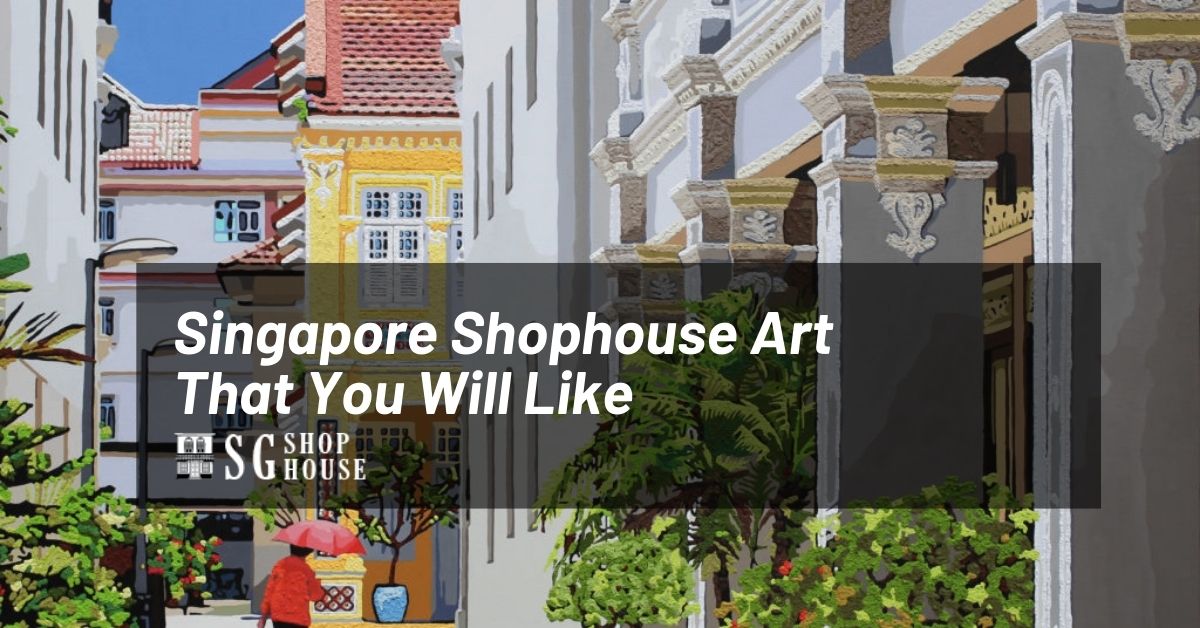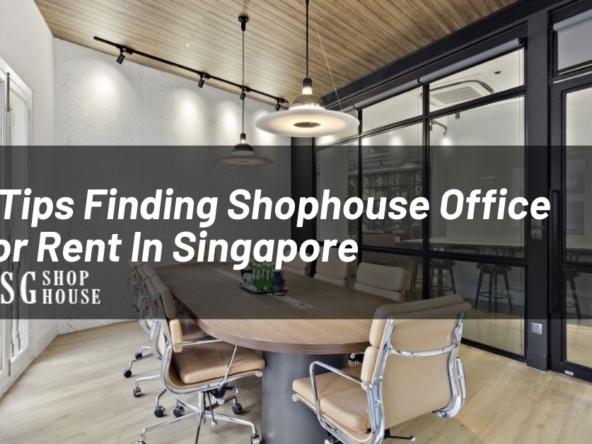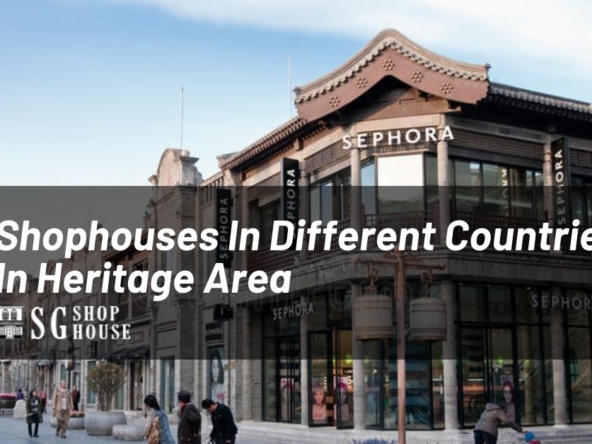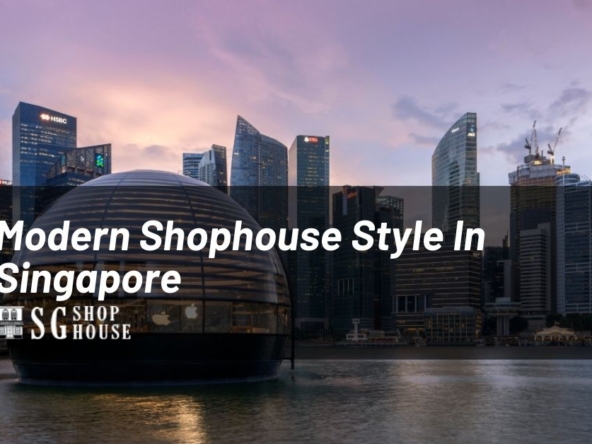Shophouses are a historical style building common throughout Singapore’s architectural landscape. These distinctive narrow terraced buildings generally 2-3 stories high and given their name as the ground floor generally used as a shop, with the upper floors be using as living quarters. Today you will see many of these historic buildings lovingly restored for both residential and commercial use. Here is the Singapore Shophouse Art that you will like.
1.Singapore Shophouse Artwork
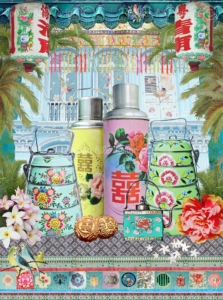
The ‘Singapore Shophouse‘ print created by Louise Hill Design as a fun and vibrant representation of the famous and much-cherished heritage shophouses dotted around the city. The artist incorporated the traditional Peranakan colour palette into this design with the use of various vintage detailed embroidered fabrics, tiles, tea flasks, and tiffin carriers that the artist has collected over time and photographed. Can you see the ‘beaded bird’? The artist found him as a detail on an old Peranakan ladies purse whilst hunting for props alongside the pretty pink and gold hand-painted bowl nestled amongst the tiles at the bottom of the print. This print is available for purchase at this link.
2.Singapore Shophouse Art: Emerald Hill Shophouses

The Peranakan Shophouses of Emerald Hill are one of Singapore’s best addresses, formerly Plantation land, it was wealthy Chinese Peranakan Spice Merchants or Straits Chinese who inhabiting these ornate buildings just off Orchard Road. The decorative style is also calling as Chinese Baroque. Emerald Hill flanked with Shophouses on either side and the fronts feature decorative plasterwork, painted shutters, and decorative Peranakan tiles. The heavy scented Frangipani & Tropical Sealing Wax Palms in the gardens complete this charming look of Singapore’s heritage past.
3.Amoy Street Shophouse Sketches

The shophouse that the artist intended to sketch in Mosque Street closed on Sunday which forced a rather pleasant stroll through the backstreets to the north of Chinatown. Amoy Street completely deserted and provided plenty of shade from the rain and sun under the ‘five-foot passages’ of the shophouses on each side of the road. Having recently flicking through Mrs M’s ‘Singapore Shophouse’ book by Julian Davison. The artist really enjoying analyzing the different styles. The friezes and characters on the wall of 115 Amoy Street are typical of the early Chinese style. The somewhat isolated building at 51 Amoy Street looks like the Baroque style with the distinctive triangular shapes on top of the two-stage classical pillars.
4.Singapore Shophouse Art: Singapore Symphony
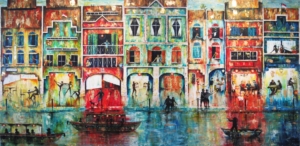
A fictional perspective of life on Boat Quay. An orchestra of people, music, sights, and smells. Satay men fan their cuisine, whilst Mah Jong and fishing add content to this composition, creating a Singapore symphony for all to enjoy.
5.Joo Chiat Shophouses
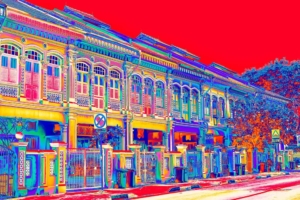
These vibrant shophouses of Koon Seng Road, Joo Chiat are a historical source of delight and nostalgia. Shophouses are an instantly recognizable building style in Singapore. Their head-turning features, bold use of colour and fancy tiles, as well as the eclectic mix of Chinese, Malay and European elements, make them favourite icons of both tourists and locals alike.
6.Singapore Shophouse Art: Clarke Quay Shophouses
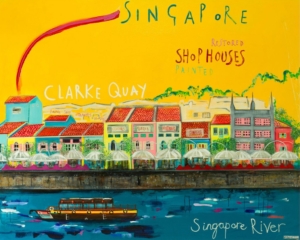
Clarke Quay district of Singapore is now a vibrant nightlife area. The Singapore River is part of Singapore’s trade route when spice merchants would bring nutmeg, mace, and cinnamon which store in and sold from the pastel-coloured Shophouses buildings in Singapore, a trade route in Asia. This painting brings to the viewer a synergy of Singapore’s vibrant neighbourhoods and heritage architecture.
7.Blair Plain Refined Rococo Style Shophouses – 1920’s
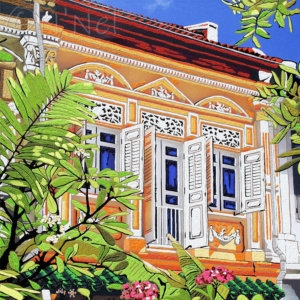
The Rococo Style remained in vogue until the end of the 1920’s, at which point in time it began to overtake by more modern influences. Most of the shophouses on Blair Plain date from the early 1920’s. They reflect an eclectic mixture of Chinese, Malay, and European design elements like the Chinese roof eaves, the Malay style shaped air vents, the European tiles. Together all these shophouses constitute some fine example of the more refined Rococo townhouse style.
8. Singapore Shophouse Art: Baba House
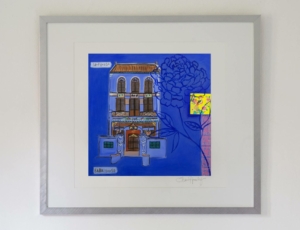
157 Neil Road, namely Baba House, is a three-storey townhouse located in Singapore’s historic district of Blair Plain. Once the ancestral home of a Peranakan Chinese family, it has since become a heritage house and you can visit to experience a typical Peranakan Chinese family home of the early 20th century. It also facilitates research into architectural conservation, urban and social history, and cultural hybridity.
The Peranakans were the Chinese-Malay traders who brought spices from the Orient into Singapore, and the much-renowned Shophouses in Singapore were their live/work units. The artist loves this building because it painted a vibrant ultramarine blue. The Peranakan culture is highly decorative and this elaborate design can see in their decorative tiles, clothes, and food. The phoenix and the peony are common symbols in Peranakan design and textiles and the artist has incorporated these elements into the piece.
9.Kitchener Road Shophouses
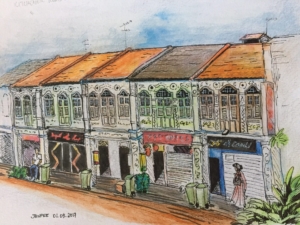
The artist quite pre-occupied with drawing shophouses. The type that’s built decades ago when traders from China and India set up Southeast Asia’s first brick-and-mortar retail establishments. We don’t have ancient places of worship, old cobbled roads and pavements, ancient giant walls to keep out enemies….we have lots of modern city buildings like Malls and towers in the CBD areas. And, we have the ubiquitous and humble shophouses found all over Malaysia and Singapore. So humble shophouses that have provided for nearly everything such as food & beverage, groceries, toys, clothes, etc in the artist’s growing years feature largely in the artist’s artwork.
The above is a watercolour and ink work that completed by the artist when taking a break from playing with acrylics. This row of shophouses can find along Kitchener Road, in the vicinity of Little India. The motifs on the building are decidedly Peranakan or Straits-Chinese. See the wriggly ink on the walls that are supposed to be flowers. And, nothing is opening given that it is mid-afternoon. A couple of bars and restaurants will open for business a few hours later. A woman walks by, taking shelter from the sun which was hiding by the clouds anyway. A man awaits his Uber ride. It was a very warm and balmy afternoon. And, the artist snapped a photo on the iPhone. As the artist couldn’t possibly do this ‘en plein air’ as many accomplished artists do!
10.Singapore Shophouse Art: Chinatown Shophouses In Singapore
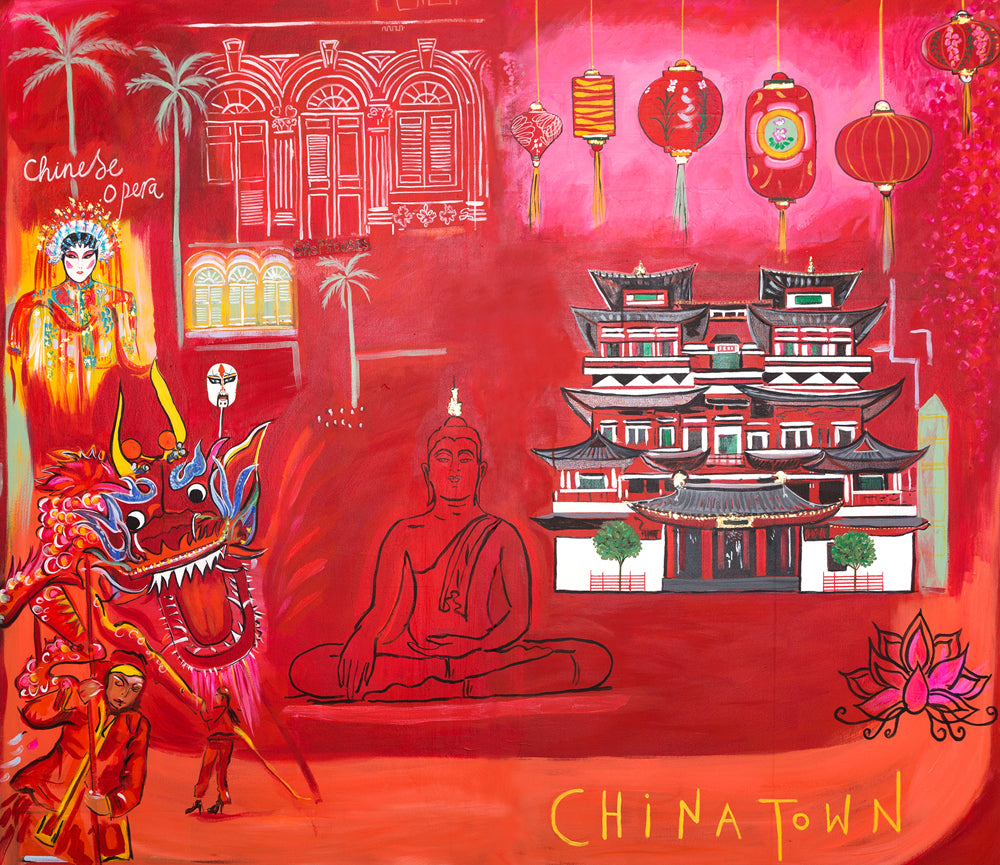
The artist loved creating this vibrant image combining all the elements. The one that makes up the unique visual feast of Chinatown Singapore. Chinatown is one of the most vibrant neighbourhoods to visit in the little red dot. A riot of colour is everywhere from the buildings to the cakes, trinkets. And, beautiful lanterns on sale in the shops and night markets. And, together with the sizzle and aroma of street food on Jalan Makalan. It is part of the sensory Chinatown vibe. One of the artist’s favourite places to visit. Especially when the artist had family or guests in town is The Chinese Opera Teahouse. A showcase for the traditional dance form where you can see up close the exquisite detail of the make-up. And, the costumes of the talented dancers.
Shophouses are prevalent in Chinatown, traditionally these are the live-work units of Chinese Peranakan Traders. They paint a variety of colours but many are red and cream or red and white. The most prominent building in Chinatown is of course The Buddha Tooth Relic Temple. A Buddhist temple and museum complex built in the Tang Dynasty architectural style which houses a molar of Gautama Buddha. And, there is an impressive giant prayer wheel at the roof terrace. The one where you can send your wishes out into the universe. At celebration time especially in the lead up to Lunar New Year. Spectacular dances of the Dragon to ward off spirits. And, the Lion to bring in an auspicious year is a focus of street life in Chinatown.


